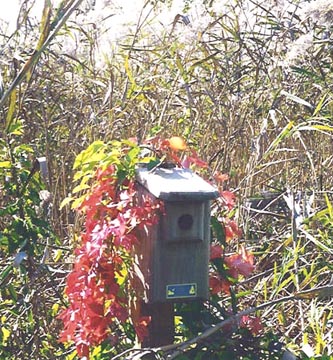
   |
 |
|
|
Bluebird Houses
|
|||||||||||||||||||||||||||||||||||||||||||||||||||||||||||||||||||||
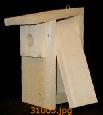 Coveside Eastern Bluebird House Kit
Coveside Eastern Bluebird House Kit
This bird house has a 4"x4" floor, which is suitable for a variety of small birds: chickadees, titmice, wrens, warblers, nuthatches and tree swallows. Includes a predator guard that is essential to provide protection for bluebirds. Easy to assemble with instructions and bird information included. (14"h x 6"w x 7-1/2"d) |
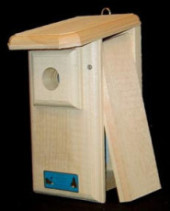 Coveside Eastern Bluebird House
Coveside Eastern Bluebird House
The finest bluebird house on the market! Predator guard is standard to keep starlings, squirrels and other undesirables out, while small floor discourages sparrow nests. RANGE: Breeds east of the Rockies from southeastern Canada to Gulf of Mexico. Winters in southern part of breeding range and Mexico. HABITAT: Enjoys open woodlands, fields and farmlands with scattered trees. (12-1/2"h x 6"w x 8-1/2"d) |
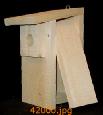 Coveside Economy Bluebird House
Coveside Economy Bluebird House
Same functionality as our standard Eastern Bluebird House, but a "no frills" variety without the pretty features that don't impress the birds. For those who want to put up an extensive bluebird trail at a reasonable price. (12-1/2"h x 6"w x 8"d) |
 Coveside Horizontal Bluebird Box
Coveside Horizontal Bluebird Box
Designed by Frank Zuern to be a safer nesting place for Eastern Bluebirds, this horizontal box simulates a hollow tree branch. Over 90% nest near the back of the box, behind a vertical baffle, out of the reach of predators. RANGE: Breeds east of the Rockies from southeastern Canada to Gulf of Mexico. Winters in southern part of breeding range and Mexico. HABITAT: Prefers open woodlands and farmlands with scattered trees. (6-1/4"h x 6"w x 19-3/4"d) |
 Coveside Mountain Bluebird House
Coveside Mountain Bluebird House
The largest of the bluebird houses, this box provides an ideal cavity for the only "all-blue" bluebird. RANGE: Breeds from southern Alaska, Mackenzie and Manitoba south to western Nebraska, New Mexico, Arizona and west to the coast. Winters from British Columbia and Montana south through western U.S. HABITAT: Breeds in high mountain meadows with scattered trees and bushes; in winter descends to lower elevations, where it prefers the plains and grasslands. (12-1/2"h x 7-1/4"w x 9"d) |
 Coveside Open Top Bluebird House
Coveside Open Top Bluebird House
This sparrow-resistant house, similar to our standard bluebird house, has a circular opening in the roof. Naturally, bluebirds will nest in rotten fence posts and stumps, so sun and rain do not deter them. On the other hand, sparrows are not as tolerant. A durable, coated wire barrier prevents predators from entering through the top. In addition, a plastic cap is included to provide shelter after the bluebirds have started nesting and/or can be used to feed mealworms to hungry chicks. RANGE: Breeds east of the Rockies from southeastern Canada to Gulf of Mexico. Winters in southern part of breeding range and Mexico. HABITAT: Enjoys open woodlands, fields and farmlands with scattered trees. (12-1/2"h x 6"w x 8-1/2"d) |
 Coveside Slant Front Bluebird House
Coveside Slant Front Bluebird House
This design is popular because it discourages cats and other predators. Since the bottom tapers, less nesting material is needed. The front opens easily for observation and cleaning. Mount this box high on a post so that potential occupants can be easily observed from a distance. RANGE: Breeds east of the Rockies from southeastern Canada to Gulf of Mexico. Winters in southern part of breeding range and Mexico. HABITAT: Enjoys open woodlands, fields and farmlands with scattered trees. (17"h x 7"w x 9"d) |
 Coveside Slate Squirrel Guard
Coveside Slate Squirrel Guard
This guard is used with the following nesting houses: Window Nest Box, Chickadee, Nuthatch, Titmouse, House Wren, all Bluebird Houses, Saw-Whet Owl and Kestrel. This guard will protect the box from chewing squirrels. |
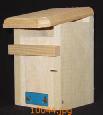 Coveside Sparrow Resistant Bluebird House
Coveside Sparrow Resistant Bluebird House
This Kentucky style, slot entrance bluebird house is designed to thwart sparrows. According to research at the University of Kentucky, bluebirds prefer a slot entrance to the standard circular hole -- sparrows prefer the opposite. In addition, sparrows don't like a shallow box and bluebirds don't seem to mind. This box is only 5" deep but if sparrows still continue to be a problem, a wooden insert is included to reduce the depth even more. Sparrows rarely use the 3-1/2" depth, but bluebirds will still occupy it. RANGE: Breeds east of the Rockies from southeastern Canada to Gulf of Mexico. Winters in southern part of breeding range and Mexico. HABITAT: Enjoys open woodlands, fields and farmlands with scattered trees. (10"h x 6"w x 8-1/2"d) |
 Coveside Western Bluebird House
Coveside Western Bluebird House
Needing a slightly larger chamber and entrance hole than their eastern counterpart, this house is ideal for the vivid Western Bluebird. RANGE: Breeds in throughout the West, north from western Alberta and southern British Columbia, south down the West Coast to Baja and east to eastern New Mexico and western Texas. Winters within most of the breeding range. HABITAT: Loves open woodlands and pastures. (12-1/2"h x 6-3/4"w x 9"d) |
 Coveside Wood Chips Nesting Material
Coveside Wood Chips Nesting MaterialNesting Material. Gallon size. |
 Coveside Wood Predator Guard
Coveside Wood Predator Guard
Used to protect baby birds form predators reaching in and grabbing them. |
|
Ads by Google |

Home
Page |
Product Review Page | Help
 Woodside Gardens
The Registry of Nature Habitats
Woodside Gardens
The Registry of Nature Habitats 
 1999 -
1999 -
All Rights Reserved
Last Updated:
